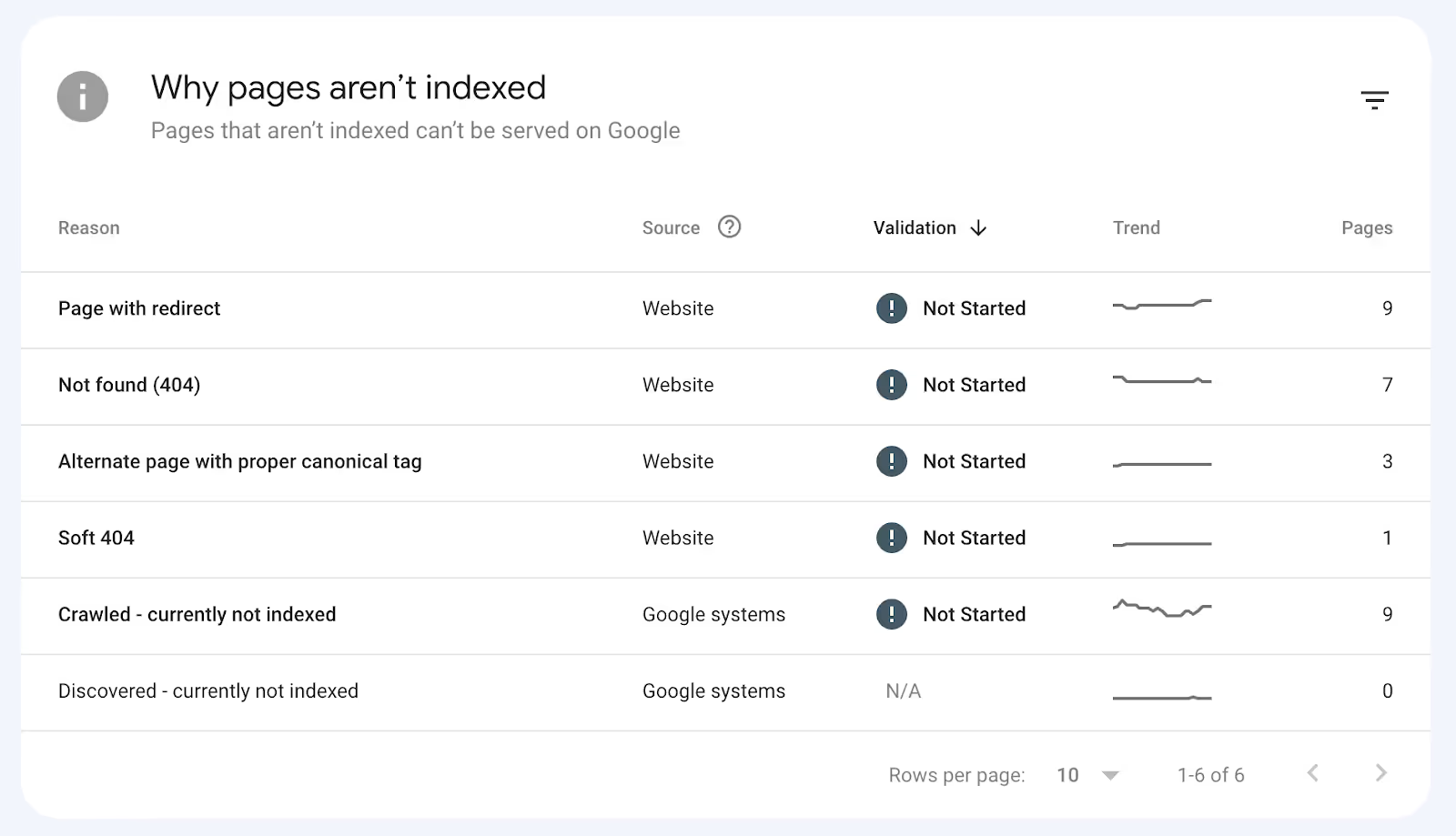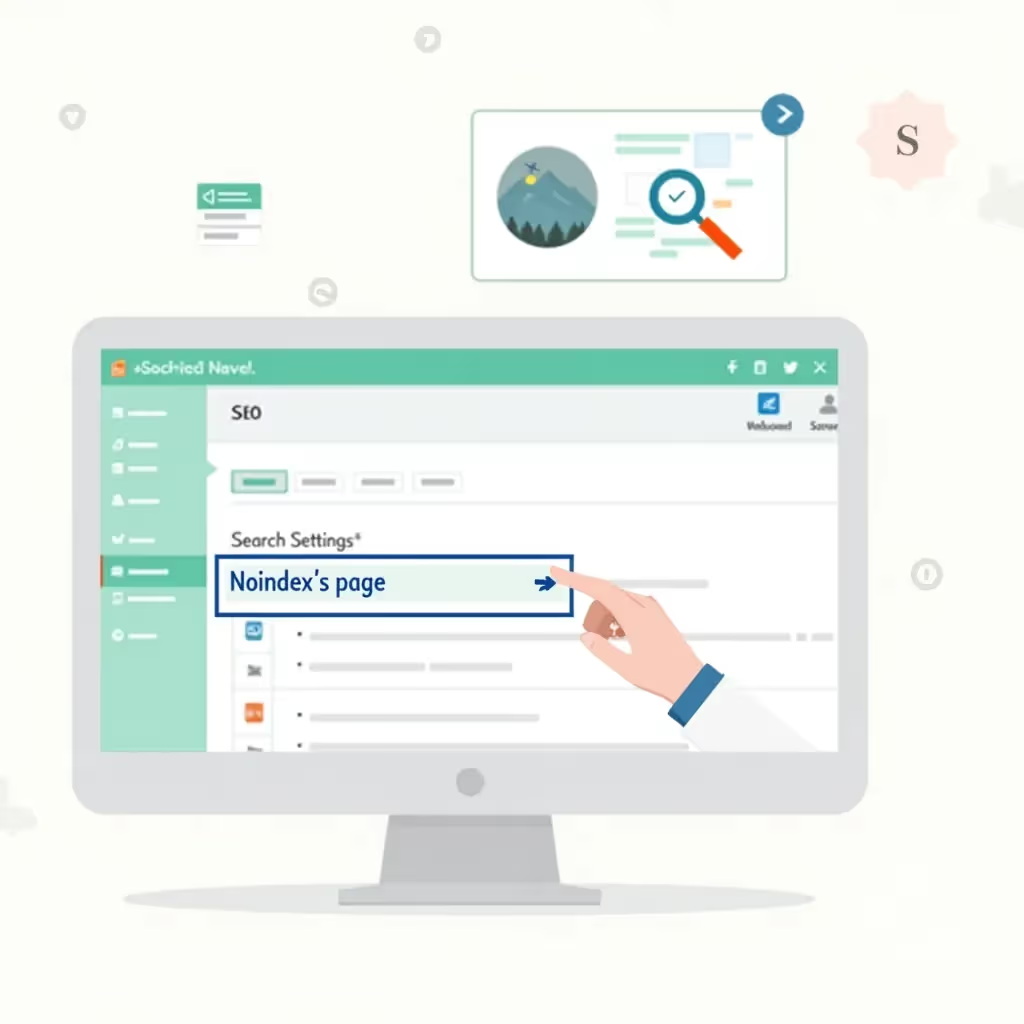Sudden changes in search engine rankings can be incredibly frustrating. And as of late, search results have been more volatile than ever.
When it comes to building organic search channels, there’s a lot we can’t control — but fortunately, there’s also a lot we can control. So when you’re diagnosing search engine ranking issues, there are plenty of things to check for and a number of steps you can take to improve the quality of your pages and their rankings in search results.
If your search results have recently dropped, the first step is to avoid panicking. The next step is to get to work. You’ll need to identify the root of the problem, determine whether the ranking drops are sitewide or specific to certain pages, and then take measures to improve rankings.
In this article, we’ll walk you through our process for navigating ranking changes and provide twelve steps you can take to troubleshoot drops in performance.
Step 1: Check for Algorithm Updates
Google constantly works to improve its algorithms and the results it displays for searchers. According to Google, there have been nine separate algorithm updates thus far in 2023.
Algorithm updates come in varying shapes and sizes and often target specific issues that Google has identified within search results. For example, in November 2023, Google released an algorithm update focused on product reviews. Algorithm updates — as well as updates that are a bit broader in scope, which Google refers to as core updates — can impact search results generally.
If your search engine rankings have recently dropped, you should check to see whether Google has recently announced an algorithm update. Google provides a list of these updates on their Google Search Status Dashboard, along with details such as the date on which the update was introduced and the update’s rollout timeline.

It will often take one to two weeks for an algorithm update to fully roll out, so don’t be surprised if you notice volatility in the weeks preceding an algorithm update.
You can also follow Google Search Central on X (formerly Twitter). Google Search Central provides updates about algorithm changes as they’re happening.
If you believe that an algorithm update has impacted you, you’ll need to identify the purpose of the update in order to understand why your website may have been affected. Google will provide some context as to why they introduced an algorithm change if the change was introduced to solve a specific issue, for example, to prevent low-quality product reviews, spam, or unhelpful content from impacting search rankings. But Google is generally less helpful in terms of giving recommendations when releasing core updates.
It’s possible that an algorithm update will impact only a portion of your website; however, it’s more likely that an algorithm update will impact the rankings and performance of your entire website. Later in this article, we’ll talk more about determining which pages were impacted.
Step 2: Check for Manual Actions
After checking for algorithmic changes, if your website has experienced a sitewide drop in rankings, the next step would be to check for manual actions within your Google Search Console (GSC) account.
GSC is a free tool, provided by Google, that allows website owners to track the performance of their websites in organic search.
In GSC, you can check for manual actions. A manual action would be an action taken by Google’s search team specifically on your website. Google may implement a manual action if they believe that your website is in violation of their guidelines — for example, if you purchased backlinks to your website as a means to manipulate search results.
To check for manual actions, login to GSC, select your property, and then scroll down to Security & Manual Actions on the left-hand side.

If a manual action has been placed on your website, Google will provide a reason. From there, you’ll be able to submit a reconsideration request asking Google to review your site again. (You’ll want to submit a reconsideration request only after solving the issues Google has identified.)
For most websites, the drop in rankings won’t have been caused by a manual action, and you should keep reading.
Step 3: Check for Indexing Issues
GSC provides in-depth information on the indexing and performance of your website in search results.
When you’re debugging a drop in search rankings, a good early step is to see whether your website has experienced a spike in not indexed pages, or a spike in the number of pages not being shown in Google’s search results.
In GSC, go to Pages > Indexing > Not Indexed to see a graph of the number of not indexed pages over time:

If you’ve experienced a spike in the number of not indexed pages, the next step would be to identify the reasons for the spike.
In GSC, Google provides the reasons that your URLs may not be indexed directly:

For example, a spike in Not found (404) issues might suggest that you’ve recently changed a large number of URLs on your site and have failed to implement 301 redirects properly. This would have led to a drop in rankings for your website.
Alternatively, a spike in the number of Discovered - currently not indexed URLs might suggest that there’s a content quality issue or issues with your site’s structure.
And all too often, marketing teams will accidentally add noindex meta tags to their pages during website migrations or updates. If you see a spike in the number of pages being reported as not indexed as a result of a noindex tag, you should double-check to make sure that the tag was added on purpose, and that you haven’t accidentally noindexed any important pages. A noindex tag removes a page from Google’s search results completely.
Assuming that there are no issues with the indexing of your site, let’s move on to determining which specific pages were impacted.
Step 4: Determine Which Pages Were Impacted
As mentioned previously, algorithmic changes often impact an entire website, but it’s possible that an algorithm change will impact only specific sections of a website.
After a significant change in search engine rankings, you should work to figure out whether the changes are affecting only specific URLs or your website as a whole.
In GSC’s Performance > Search Results tab, Google provides a number of metrics related to your website’s performance, including total clicks, total impressions, average CTR, and average position:

Using the filters provided in GSC, you can hone in on specific URLs on your website. You should try to determine whether total impressions have changed on a sitewide basis or only for specific URLs or particular sections of your website. You could apply a filter on the URL path, for example, to see only the changes for blog posts on a /blog/ path.
Drops or changes in average position would indicate that your ranking positions for the keywords you’re targeting, either for your entire domain or for specific URLs, have changed, which could be impacting traffic.
You could also use a keyword tracking toolset to get a more granular view of how your website and its URLs have changed over time for specific keywords. Tools like Positional, Semrush, and Ahrefs provide keyword tracking.
For example, Positional lets you track the performance of any website and its URLs over time:

In Positional, you can track the number of keywords that a given URL ranks for and the changes in those positions over time. If, for example, only certain parts of your website or specific URLs have dropped, you should prioritize those pages for improvement — more on improving these pages later.
Step 5: Check for Recent Site Changes
After you’ve identified the sections of your website that have been negatively impacted or confirmed that it was your website as a whole, the next step would be checking to see whether any major changes have taken place.
Depending on the size of your website and your team, there might be a lot to check. Here are a few things you might want to consider:
- URL structure: Did you recently change your permalink structure? If so, you’ll want to ensure that you’ve properly 301 redirected any previously indexed URLs to the new URL path.
- Internal linking: Did you substantially change internal links to or from an existing page on the website? Internal link changes could have a significant impact on the rankings for an individual URL on your website, as well as on the website as a whole.
- Title tags: Did you recently adjust the title tags for a specific page on your website? Title tags can have a big impact on a page’s click-through-rate from search results, which could lead to big changes in search engine ranking.
- Substantial content changes: Did you substantially change or modify the content on a specific page on your website? If so, Google could be processing these changes and working to understand whether the changes are helpful for a searcher. You may experience increased volatility, both positive and negative, for this specific page over the weeks after a substantial change.
- Page formatting, UX/UI changes: Did you substantially change the UX/UI of your website or pages? Have you substantially changed the above-the-fold section of your pages (doing so can greatly impact SEO performance)? You can typically expect increased volatility in search engine rankings after a large-scale site or page redesign. If the ranking issues persist after a couple of weeks, it might be best to roll back the UX/UI changes.
- Keyword cannibalization: Did you recently release a new webpage targeting keywords similar to those that an existing page is targeting? If so, you might be running into keyword cannibalization issues — in other words, confusing Google as to which page on your site should be ranking for which keyword. If Google is ever confused, due to cannibalization, as to which of two pages should be ranking for a given keyword, it’s likely that neither of the pages will perform as well in search.
This is only a partial list — you could also check for changes in meta descriptions, changes in keyword density, and issues with the content itself, for example, duplicative content.
Step 6: Check Competitors
During this time, it’s also important to check your competitor's performance in search. After an algorithm change, reviewing the changes in search engine rankings for your competitors might lead to some clues as to what you could improve.
You’ll want to use one of the keyword-tracking tools mentioned previously. Using these tools, you can plug your competitors in and see changes in ranking position and traffic for the keywords that they rank for.
There are, of course, winners and losers with all algorithm changes. It can be helpful to try to understand the characteristics of the websites that have benefited from algorithm changes or the characteristics of webpages that have dropped in rankings as a result of an algorithm change. For example, you’ll often hear about Google’s E-E-A-T guidelines, and perhaps some of your competitors do a better job of demonstrating experience, expertise, authoritativeness, and trustworthiness on their websites.
On a page level, if your rankings have dropped for just a specific URL, was that because the number of competitors for a given keyword increased? Or because the competitors substantially changed or improved their webpages?
For example, if you’ve recently been passed in the search results for a specific keyword, you should look to identify what characteristics the pages that passed you share. For example, for a specific keyword, maybe there has been a substantial change in the information required on your webpage, and competitors have been faster to update or improve their URLs.
Alternatively, you could check to see whether the webpages that have passed you have recently built a number of new backlinks, which could have had a positive impact on their rankings in search.
Step 7: Check for Changes in the SERPs
When it comes to the performance of specific webpages, it makes sense to review the current SERP presentation for the keywords you’re interested in tracking.
For certain keywords, Google is constantly updating the format and presentation of search results. A company in the recipes space, for example, might be greatly impacted by Google testing new formats to display recipes in:

If you’ve noticed significant drops in traffic for specific keywords, you should check to see whether the presentation of results has substantially changed.
Step 8: Improve E-E-A-T Signals
Google introduced its E-E-A-T guidelines to help website owners better understand how Google’s algorithms and their search raters judge the quality of a website. If you’ve recently been passed in search results by your competitors, it’s worthwhile to think critically about the E-E-A-T you’re demonstrating and the unique value your website delivers.
E - Experience
E - Expertise
A - Authoritativeness
T - Trustworthiness
There can be a lot to improve when it comes to E-E-A-T, but there’s likely not one silver bullet.
At the Bright SEO conference in San Diego, Danny Sullivan from the Google Search Team reiterated that Google’s algorithms try to associate characteristics of your website and pages with high-quality websites or authoritative websites. For example, adding an author bio page to your website might not move the needle immediately, but it’s a factor that will likely go into Google deciding that your website is a high-quality one.
A few things to check:
- Does your website clearly display authors and bylines?
- Does your website clearly explain why the authors on your website are experienced?
- Does your website have a Terms of Service section and a clearly accessible Contact Us page?
- Does your website demonstrate trust above the fold?
- When making claims in your content, are you using and citing reputable sources?
- Are you adding first-party experience or expertise to your webpages, or simply regurgitating information you’ve found from other sources online?
Again, improving your E-E-A-T will likely not lead directly to improvements in rankings. But over the long term, investing in improving your E-E-A-T will create a better experience for searchers, and your website will likely be rewarded for that.
Step 9: Improve Content Quality
When it comes to ranking well in organic search, content quality is arguably more important than it has ever been. Content quality is important at both the page level and the domain level. We should be creating fantastic content. So what is fantastic content?
We ask this question fairly often on our weekly SEO podcast, Optimize. On a recent episode, we asked Kevin Indig, the creator of the Growth Memo newsletter, about crafting fantastic content. Here’s what he said:
“Typically, the pieces of content that perform better in search go a couple of clicks deeper than those that don't and stay relatively high level. Depth goes into how deeply you cover topics. And to be fair, you can go infinitely deep on things. So there has to be some cutoff point. And there is no perfect formula to where that cutoff point is. So when you bring depth to a piece, you naturally have to write more, even if you keep your writing concise and to the point. On the other hand, longer content, for the sake of length, introduces an element of fluff that is easy to suss out, for users and Google.”
At a page level, we want to put our best foot forward with the content that we create. Our pieces of content should be uniquely helpful and address the search intent of the keywords we’re trying to rank for. We also want our pages to be similar in structure to the pages currently ranking best for a given keyword.
There are a number of tools you can use for content optimization, including Positional’s Optimize toolset, Clearscope, and Surfer. These tools provide recommendations for improving your existing content and optimizing it for long-tail keywords.
At the domain level, Gary Illyes from Google’s search team has recently stated that Google looks at sitewide signals to determine quality, and this could include content on a subdomain. If you have large amounts of low-quality content, whether it’s thin content, duplicative content, or low-quality AI-generated content, these pages could be negatively impacting the higher-quality pages on your website. And if you do have large amounts of low-quality content, you should work to go back and improve it.
Revamping and refreshing previously published content, at both a page and domain level, can often lead to much bigger traffic gains than creating new pieces of content. At least once per year, it makes sense to go back to every piece of content on your website and determine what could be improved, what is outdated, or what could be done to make the page more helpful.
Step 10: Check for Changes in Search Intent
Search intent is simply the reason someone is conducting a search. Thinking about search intent will help you fully address the searcher’s questions or intent with your webpage. You always want to ensure that you’re delivering the right type of page for the specific search query.
And search intent will often change over time. If you’ve recently experienced a drop in the performance of a specific page on your website, it could be that the search intent no longer aligns with the page you’ve created.
For example, early in my career, we attempted to rank for keywords like “best student loans” with product and landing pages. However, it became clear over time that Google was starting to prefer blog posts for such keywords and not landing or product pages — and that if we wanted to rank for “best student loans,” we’d need to deliver a blog post.
You should check the current search results for each keyword you’re interested in and ensure that the type of page you’ve created is aligned with what’s currently ranking best for that keyword.
For example, if you see that search results are now favoring landing pages for a given keyword, you should try to rank for that keyword with landing pages instead of blog posts.
Step 11: Check for Backlink Issues
Improving Domain and Page Authority
Backlinks are links to your website from other websites. Backlinks have been and will always be an important ranking factor.
By now, most of us probably know that increasing the number of quality backlinks to your website will positively impact the performance of your pages in organic search. There are many different ways to build backlinks, including guest blogging, creating resource pages, and using digital PR or data-driven content.
Backlinks are important at both a page level and a domain level. You’ll often hear of domain authority, often used interchangeably with PageRank, or the calculation of the strength and quality of the backlinks pointing to your website.
If you’ve recently noticed a dropoff in search engine rankings for a specific page on your website, check to see whether the pages that have passed yours have higher page authority. Page authority, like domain authority, is a calculation of the strength and quality of the backlinks going to a specific page on your website.
Removing Negative Backlinks
Unfortunately, there are a lot of websites that, well, you wouldn’t want to get a backlink from.
Google’s algorithms have gotten increasingly good at identifying low-quality or spammy backlinks. And by and large, Google will simply ignore them.
However, a spike in the number of low-quality backlinks going to your website could, in theory, be harming your website's reputation and search engine ranking. Even worse, some websites might experience a targeted or malicious backlink attack campaign mounted by competitors looking to outrank them. In other words, certain unsavory companies might intentionally build low-quality backlinks to their competitors’ websites in order to harm their search performance.
Fortunately, Google does allow you to disavow backlinks pointing to your website. In GSC, you can upload a list of backlinks that you’d like Google’s algorithms to ignore. This tool should be used with caution and only if there is a targeted attack on your website or if you’ve previously built harmful backlinks to your website (for example, by purchasing low-quality backlinks).
Most of the readers of this article will not need to use the disavow tool and should instead focus on the other suggestions included in this article first.
Step 12: Improve User Experience Metrics
If you’ve noticed a drop in the performance of a specific webpage on your website, you should check the user experience metrics for that webpage.
User experience metrics like scroll depth, bounce rate, and time on page help Google understand whether people are enjoying your content and webpages.
Using a tool like Google Analytics, or Positional’s Content Analytics toolset, you can view user performance data for each page on your website.
If you’ve noticed a spike in bounce rate for a particular page or a reduction in scroll depth, that might signal that something on your page needs to change or that your page is no longer serving the search intent for the keywords you’re looking to rank for. Moreover, poor user experience numbers might also signal that the content on a page needs to be improved or is not that helpful.
Positional’s Content Analytics toolset provides a granular heatmap that shows which sections in your content could be improved or which sections are causing a substantial amount of user dropoff. These would be sections to rework or improve — by improving these sections, you could improve user experience, and better performance in these areas will signal to Google that your webpage is of higher quality and deserving of higher rankings.
Final Thoughts
Recovering from a drop in search engine rankings depends on many different factors. And how long it takes to recover fully depends on whether the drops are at a domain level or only at a page level.
For domain-level changes and dropoffs, regaining lost ground will likely take longer, as it takes more time to improve your entire website, and it will also take time for Google to process these changes.
At a page level, it can be a lot easier and faster to improve search engine rankings after a dropoff. For example, if a title tag recently changed, leading to a dropoff in traffic, you could revert back to the previous version. Alternatively, you could experiment with adding additional internal links to the pages that have dropped off, or with changing the anchor text on those internal links if you’re looking to target certain keywords more specifically. And of course, you could always work to build backlinks to certain higher-value pages on your website and to increase the domain authority of your website as a whole.
One thing is for certain: almost everything in SEO is fixable; it just requires work. Even a manual action, which is highly unlikely for most of the readers of this article, can be addressed and solved.
Having the right tools for first identifying root causes and impact and then implementing improvements is important. In this article, we’ve highlighted a number of tools that you can use, including Positional. At Positional, we’re building a modern set of tools for content marketers and SEO teams, including tools for content optimization, tools for keyword and performance tracking, and analytics tools for judging the experience that searchers are having on your pages.





